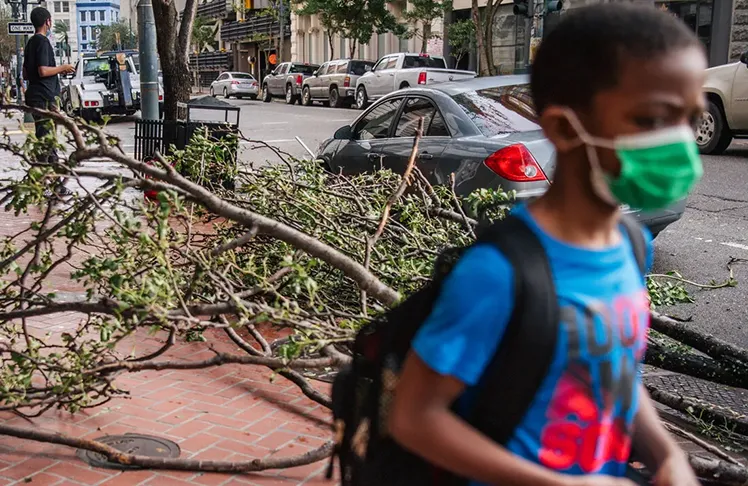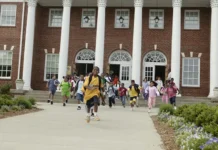

This article is one of a series of articles produced by Word in Black through support provided by the Chan Zuckerberg Initiative. Word In Black is a collaborative of 10 Black-owned media outlets across the country.
In 2017, Christina Boyd-Patterson was a high school senior when the remnants of Hurricane Irma — a Category 5 storm when it hit Texas — swept through Jacksonville, Florida, where she lived and went to school. The storm inundated her city, forcing schools to shut down for weeks.
“I know the hurricane affected everyone at my school just as much as me, but it was a lot,” Boyd-Patterson tells Word in Black. Among other things, she fell behind on college applications, but “at least I didn’t have to repeat a year, like some of my classmates did.”
Data, including a recent government report, highlights the problems Patterson, now 25, faced.
From mental health challenges to prolonged school closures, Black students whose lives and education are disrupted by devastating weather events face greater obstacles in the aftermath, issues that widen existing inequities in education.
According to the U.S. Government Accountability Office, most school districts that received disaster recovery funds between 2017 and 2019 served high proportions of socially vulnerable students. Districts with large numbers of Black and Brown students, the report states, require significantly more recovery assistance than those with less vulnerable populations.
But studies also show vulnerable Black communities often receive less financial support for disaster recovery overall than their white counterparts. That means schools in those communities are closed longer, have fewer resources to repair or rebuild and less support for students who may be struggling emotionally, living in temporary housing or homeless.
The data take on new significance as the aftermath of back-to-back hurricanes, Helene and Milton, grinds on in Florida, Texas, Georgia and western North Carolina. And it comes as climate change has made intense, destructive storms the new normal.
Tatiana Samuels, a guidance counselor in Jacksonville, Florida, says the frequency of school closures after disasters has become so routine that “it almost feels like a drill.”
“During teacher planning days, it’s something we always prepare for,” she says. “I always worry about the students’ mental well-being when they return to school, especially when we as school administrators don’t have many resources to offer them.”
Federal Aid Disparities and Delayed Recovery
A significant factor is the disparity in federal aid distribution. A 2022 study in Center of American Progress revealed that Black survivors of natural disasters saw their wealth decrease by an average of $27,000, while white survivors saw their wealth increase by $126,000. This disparity affects the ability of these families to rebuild their homes and stabilize their children’s education, further hindering recovery.
The aftermath of Hurricane Harvey, which tore through southeastern Texas and Louisiana in 2017, just months after Irma, is a striking example. After the disaster, the number of homeless students soared by 351%, with around 8 in 10 students unhoused by the storm. The sudden displacement disrupted schooling for nearly 24,000 students.
Last year, the NAACP reported that counties with higher Black populations receive less FEMA funding than predominantly white counties despite experiencing similar levels of damage.

Black Mental Health and Emotional Trauma
Black students’ mental health challenges after a natural disaster only add to the disparities. Exposure to disasters like hurricanes can lead to post-traumatic stress disorder in survivors, and Black students — who are more likely to experience housing instability and food insecurity post-disaster — are the most at risk.
Schools in disaster-affected Black communities often lack the resources needed to adequately support students’ mental health. Following Hurricane Harvey, many schools in low-income areas reported a shortage of qualified mental health providers. That left many students without the emotional support to recover, a factor in long-term academic and behavioral challenges.
Educational Setbacks and Learning Loss
Black students whose lives and education are disrupted by a major event are substantially more likely to fall behind academically and are vulnerable to absenteeism and at increased risk of dropping out. Research shows that extended school closures from natural disasters lead to long-term setbacks, particularly for Black students.
The learning loss typically involves lower test scores and decreased graduation rates.
Meanwhile, student displacement — relocations to temporary shelters or different schools due to storm-related damage at their home school — also disrupt students’ education and can limit access to resources critical to academic success, such as internet connectivity or tutoring,
A Path Forward: Ensuring Equitable Recovery for Black Students
To ensure these students can recover and thrive academically post-disaster, systemic changes in disaster response and recovery funding are necessary.
Samuels, the Jacksonville teacher, says federal aid “often fails to prioritize those in Black and Brown communities, which means the school districts in those areas are also disproportionately impacted.” School districts, she says, should designate an official “to work directly with federal organizations like FEMA to ensure the proper amount of aid is being provided, especially to communities of color.”
Along with providing relief for students affected by natural disasters, Samuels says officials must adequately prepare for the new normal — more powerful storms that lead to increased disruptions in education.
“Educators and community leaders must ensure schools are prepared for future disasters while providing immediate support for affected students. This includes expanding access to mental health services, ensuring equitable federal funding for recovery, and creating disaster preparedness plans.”















